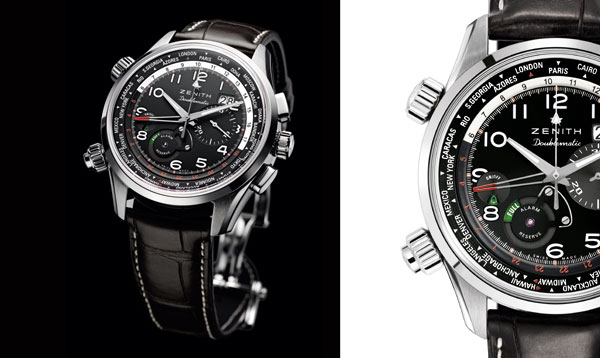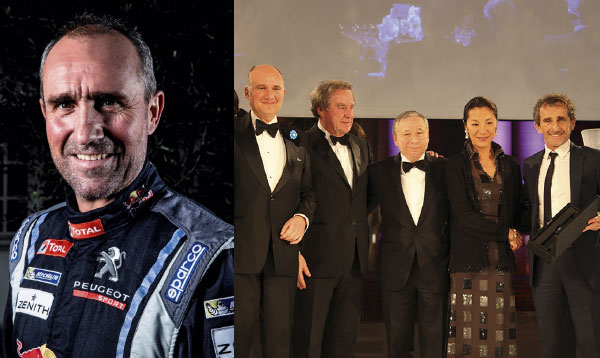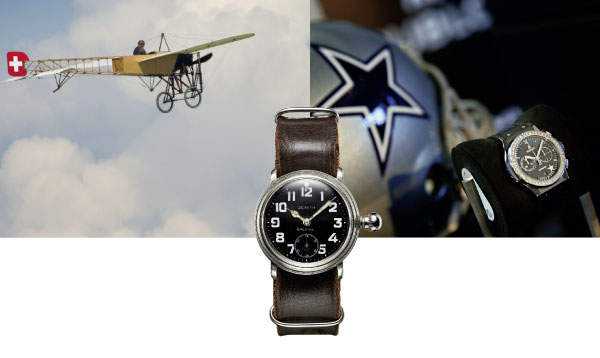
On the outside
The exterior of the watch is often considered a purely stylistic feature, but it also plays a major technical role. This is particularly true of pilot’s watches. The most important criterion is to have a dial that is easy to read. The recognised aviation standard is a black dial with white hands and numerals — a combination that provides the best clarity in all lighting conditions. The Doublematic model complies with this standard and provides a clear indication of the time on a rather cluttered dial. Its matt black surface makes a nice contrast with the effective luminous coating of the hands and numerals in snowy white.
The steel case, also available in pink gold, measures 45mm in diameter, just enough to display the indications distinctly and accommodate the various control buttons around the caseband without resorting to a cumbersome lump of metal. The bevelled sapphire-crystal glass rises a generous 2mm above the bezel for visual effect, protecting the latter from scratches. The crown and the chronograph buttons are on the right of the caseband; on the opposite side can be found a crown to set universal time and another, equipped with a button, controls the alarm functions. The combination looks ready for action and the design is modern with the stylistic features going back to the early days of the El Primero movement.
The works
Among the many movement calibres produced by the Le Locle manufacturing company, the high-frequency El Primero chronograph movement vibrating 36,000 times an hour is undoubtedly the star. The impressive feature of this movement here is its mechanical efficiency, despite having to drive a large date, universal time and an alarm in addition to its usual chronograph functions. The chronograph does without an hours counter and running seconds. In addition to the central chronograph seconds hand, the function includes a 30-minute counter in its usual position at 3 o’clock. We needn’t go into the basic movement and the chronograph functions since these are well known and have already been reviewed. Nevertheless we can point to the column-wheel that orchestrates the functions and to the fact that this was the first chronograph that measured the tenths of a second. The additional functions are more worthy of interest, starting with the universal time for a flight crossing several timezones. This is arranged around the edge of the dial with the names of the cities in full for optimal legibility.
Appearing above the 30-minute counter, the large date has all the attributes of greatness. The disc for the tens is concentric with that of the units, which is pared down to bring them to the same level. This construction avoids the inelegant step between the two discs and allows an unbroken aperture in the dial. It furthermore prevents the two discs going out of phase because of tight clearances. Opposite are the essential alarm indications. The alarm hand is in the centre so that the time can be set exactly. A small aperture at 8 o’clock indicates whether the alarm is turned on or off. One useful, if not indispensible feature, is an indication of the power reserve available in the spring powering the alarm. The sapphire-crystal caseback reveals the movement’s impeccable finish.
The tests
As an indication of the confidence Zenith has in the quality and reliability of this new model, the watch made available for testing was a prototype, in which no fault could be found. The quality of the El Primero movement is generally acknowledged. Its 5Hz frequency has given it an exemplary precision since it was launched in 1969. The horizontal balance amplitude remained above 285° whether the chronograph was running or not and did not drop below 250° when the balance was vertical. The maximum loss of amplitude after 24 hours was less than 25°. The measured rates stayed between 0 and +8 seconds a day with a variation of 5 seconds — well within the requirements for a chronometer certificate.
The additional complications, whether the large date or the universal time, take very little energy. The alarm, of course, has its own power source. There is no reduction in zenith’s indicated power reserve of 50 hours. Two measurements showed that the power reserve in fact exceeded the manufacturer’s figure by two or three hours. The Doublematic sits comfortably on the wrist and the outsize controls for the timezones and the alarm are cleverly positioned so as not to get in the way— provide the watch is worn on the left arm.
The unexpected novelty from Zenith is the alarm — a useful, though rare, complication. The alarm is rung on a gong, which gives a crystal clear sound loud enough to awaken you in a quiet environment. The duration of the alarm, which is often insufficient in his type of movement, is astonishing. The space taken up by the alarm’s barrel and mechanism seems insignificant in a watch of this size, yet it rings for a full 35 seconds. The escapement for the alarm has thus been designed and adjusted for a perfect compromise between duration and volume.
In conclusion
Pilots do not really need a wristwatch to plan or navigate their flight. Furthermore they do not time a given period, but set a time for an event such as a change of course. Nevertheless, wearing a reliable and accurate watch is one of those extra precautions that make flying the safest way to travel. Even if you’re not a pilot, it’s worth choosing a watch reputed for its accurate timekeeping and made by a company with a long and varied experience in this kind of instrument. Those who make that choice can be assured of precision and peace of mind, as well as a few hundred grams packed with legendary exploits on their wrist.






